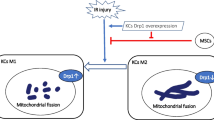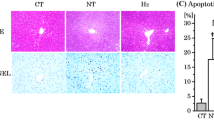Abstract
To clarify the relationship between Kupffer cells (KC) and hepatocytes in hepatic ischemia-reperfusion injury, isolated liver nonparenchymal cells (NPC), including a large proportion of KC, from C3H/HeN and C3H/HeJ mice were utilized in an in vitro hypoxia-reoxygenation system which enabled precise control of the oxygen concentration in the circumferential air during incubation. The viability of NPC, concentrations of cytokines and superoxides released from NPC, and the effects of antioxidants on hypoxiareoxygenation were investigated. The results were: (1) The deterioration of NPC was slow under hypoxia, but a significant decrease in their viability was observed with reoxygenation. These results were virtually identical in C3H/HeN and C3H/HeJ mice. (2) The concentration of tumor necrosis factor (TNF)-α from NPC of C3H/HeJ was much lower than that from NPC of C3H/HeN, and production of O −2 was lower in the NPC of C3H/HeJ than in C3H/HeN, but changes in the viability of NPCs which were reoxygenated following various intervals of hypoxia were almost identical in both types of mice. (3) Viability after reoxygenation was improved by the addition of catalase or superoxide dismutase (SOD), and further improved with the combined use of catalase and SOD. These results suggested that the changes in KC function after reoxygenation decreased the viability of the cells, due predominantly to the release of reactive oxygen metabolites, not to the release of TNF-α.
Similar content being viewed by others
References
Jaeschke H (1991) Reactive oxygen and ischemia/reperfusion injury of the liver. Chem Biol Interact 79:115–136
McCord JM (1985) Oxygen-derived free radicals in post-ischemic tissue injury. N Engl J Med 312:159–163
Jaeschke H, Farhood A (1991) Neutrophil and Kupffer cell-induced oxidant stress and ischemia-reperfusion injury in rat liver. Am J Physiol 260:G355-G362
Seglen PO (1976) Preparation of isolated rat liver cells. Methods Cell Biol 13:29–83
Tanaka K, Sato M, Tomita Y, Ichihara A (1978) Biochemical studies on liver functions in primary cultured hepatocytes of adult rats: I. Hormonal effects on cell viability and protein synthesis. J Biochem 84:937–946
Karasawa G, Hirata K (1990) The study on the mechanism of resistance of endotoxin resistant mouse: (1) Effect of endotoxin on the production of free-radicals by isolated liver non-parenchmal cells (in Japanese with English abstract). Sapporo Med J 59:119–128
Richman LK, Klingenstein RJ, Richman JA, Strober W, Berzofsky JA (1979) The murine Kupffer cell: I. Characterization of the cell serving accessory function in antigen-specific T cell proliferation. J Immunol 123:2602–2609
Bouwens L, Brouwer A, Wisse E (1989) Ultrastructure of human hepatic pit cells. In: Wisse E, Knook DL, Decker K (eds) Cells of the hepatic sinusoid. Kupffer Cell Foundation. Rijuswijk, The Netherlands, pp 471–476
Yamaguchi H, Hirata K, Yamashiro K, Mukaiya M, Katsuramaki T, Ohmura T, Zou XM (1994) Mechanism of liver injury in sepsis. Change of sinusoidal lining cells and circulatory disturbance in sinusoid (in Japanese). J Abdom Emerg Med 14:1017–1026
Deitch EA (1992) Multiple organ failure: Pathophysiology and potential future therapy. Ann Surg 216:117–134
Caldwell-Kenkel JC, Currin RT, Tanaka Y, Thurman RG, Lemasters JJ (1991) Kupffer cell activation and endothelial cell damage after storage of rat livers: Effects of reperfusion. Hepatology 13:83–95
Rymsa B, Becker HD, Lauchart W, de Groot H (1990) Hypoxia/reoxygenation injury in liver: Kupffer cells are much more vulnerable to reoxygenation than to hypoxia. Res Commun Chem Pathol Pharmacol 68:263–266
Rymsa B, Wang JF, de Groot H (1991) O −2 release by activated Kupffer cells upon hypoxia-reoxygenation. Am J Physiol 261:G602-G607
Matsuo S (1984) Studies of the kinetics of complement and the significance of complement in endotoxin shock in mice (in Japanese with English abstract). Sapporo Med J 59:191–200
Karasawa G, Hirata K (1990) The study on the mechanism of resistance of endotoxin-resistant mouse: (2) The study on capacity of cytokines production of isolated liver non-parenchymal cell by endotoxin (in Japanese with English abstract). Sapporo Med J 59:191–200
Dong Z, Qi X, Fidler IJ (1993) Tyrosine phosphorylation of mitogen-activated protein kinases is necessary for activation of murine macrophages by natural and synthetic bacterial products. J Exp Med 177:1071–1077
Kobayashi K (1988) Life time of active oxygens and their physiological significance (in Japanese). Protein, Nucleic Acid and Enzyme 33:2678–2683
Sasada M (1988) Microbial killing by oxygen radicals from phagocytes (in Japanese). Protein, Nucleic Acid and Enzyme 33:3024–3030
Essani NA, Fisher MA, Farhood A, Manning AM, Smith CW, Jaeschke H (1995) Cytokine-induced upregulation of hepatic intercellular adhesion molecule-1 messenger RNA expression and its role in the pathophysiology of murine endotoxin shock and acute liver failure. Hepatology 21:1632–1639
Asano K, Yamaguchi K, Kawai A, Mori M, Takasugi T, Umeda A, Kawashiro T, Yokoyama T (1992) Alteration of oxygen extraction and blood flow in various organs under acute hypoxia (in Japanese with English abstract). Nippon Kyobu Shikkan Gakkai Zasshi 30:2098–2104
Lindell SL, Southard JH, Vreugdenhil P, Belzer FO (1994) Kupffer cells depress hepatocyte protein synthesis on cold storage of the rat liver. Transplantation 58:867–874
Canalese J, Gove CD, Gimson AES, Wilkinson SP, Wardle EN, Williams R (1982) Reticuloendothelial system and hepatocyte function in fulminant hepatic failure. Gut 23:265–269
Nguyen DT, Eskandari MK, DeForge LE, Raiford CL, Strieter RM, Kunkel SL, Remick DG (1990) Cyclosporin A modulation of tumor necrosis factor gene expression and effects in vitro and in vivo. J Immunol 144:3822–3828
Mizel SB (1980) Studies on the purification and structure-function relationships of murine lymphocyte activating factor (interleukin 1). Mol Immunol 17: 571–577
Bhatnagar R, Schade U, Rietschel E Th, Decker K (1982) Involvement of prostaglandin E and adenosine 3′,5′-monophosphate in lipopolysaccharide-stimulated collagenase release by rat Kupffer cells. Eur J Biochem 125:125–130
Johnston RB, Godzik CA Jr, Cohn ZA (1978) Increased superoxide anion production by immunologically activated and chemically elicited macrophages. J Exp Med 148:115–127
Author information
Authors and Affiliations
About this article
Cite this article
Yamaguchi, H., Hirata, K. Effects of hypoxia-reoxygenation on isolated liver nonparenchymal cells. J Hep Bil Pancr Surg 4, 322–331 (1997). https://doi.org/10.1007/BF02489032
Received:
Accepted:
Issue Date:
DOI: https://doi.org/10.1007/BF02489032




